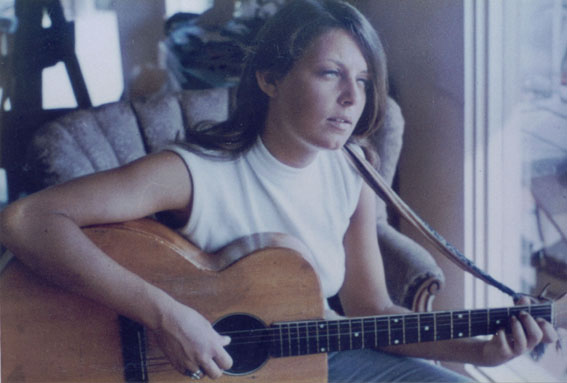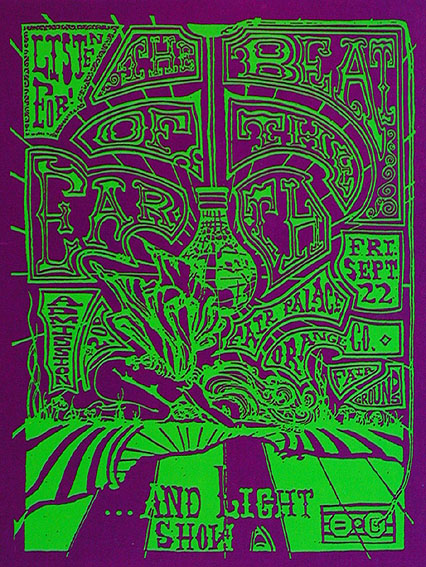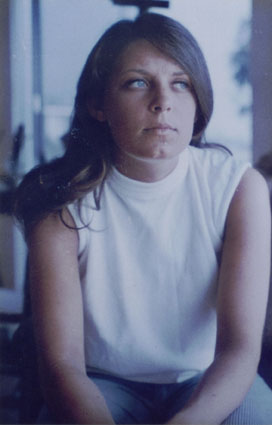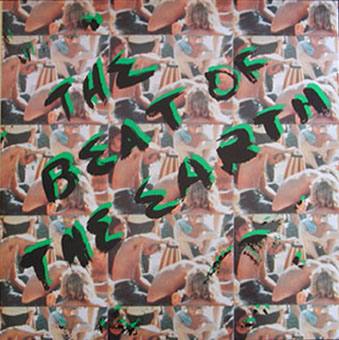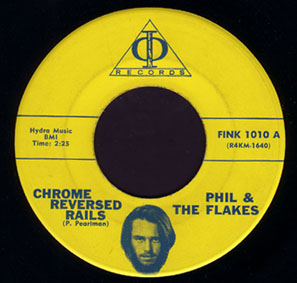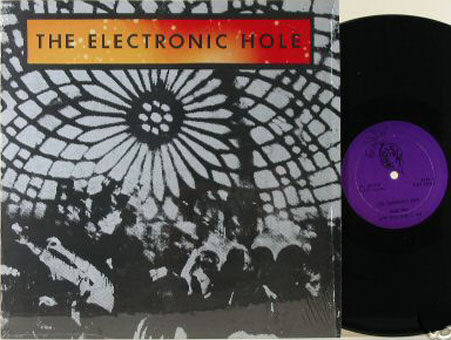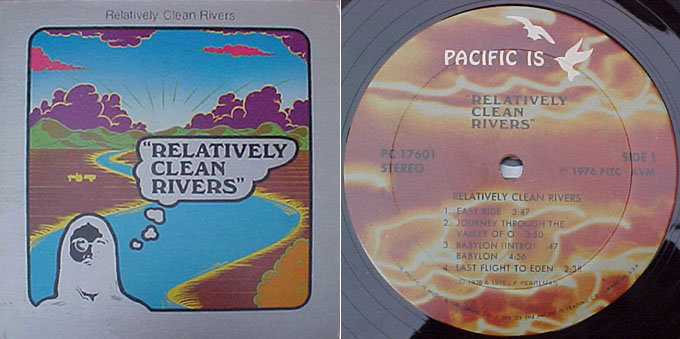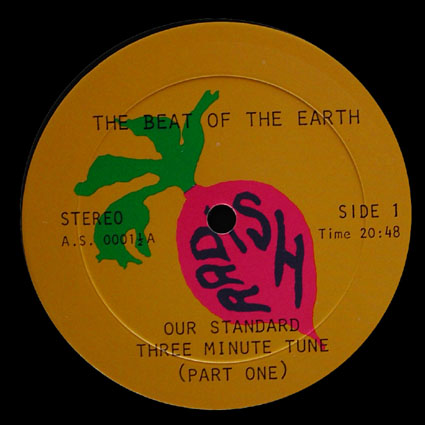THE
BEAT
OF THE EARTH
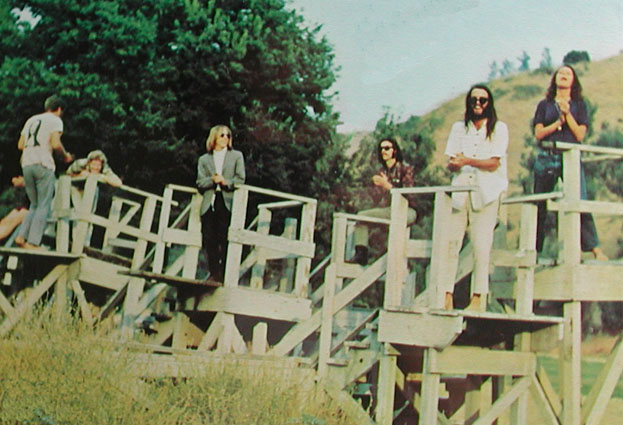 |
"The music was free-form, original, and unrehearsable, since it was all spontaneous. I remarked to Phil that it was the steady thrum one experienced when you went to a Love-In. All these small groups of musicians playing guitars, tambourines, flutes, auto-harps, bongos, anything that made sound, all simultaneously, created a type of orderly orchestral sound. The combined beats were primitive, primal, the beat of the earth..." |
|
INTRODUCTION After being
discovered by fans of underground psychedelia in the late 1980s, Orange County
band BEAT OF THE EARTH's sole 1967 album has grown into a classic
within the field, in spite of its rarity and lack of a reissue. The
improvisational music on the album cannot be easily described but
most who hear it agree that it represents a unique link between
mid-1960s California teen sounds and the droning acid rock of the
later era. I was able to connect with ex-band member Karen Darby
who gracefully shared her memories of the band and its legendary
leader Phil Pearlman. To my knowledge this is the first ever article
on BEAT OF THE EARTH, whose reputation is likely to expand further as more
and more people get to hear their unique music. KAREN DARBY INTERVIEW Q: How was the BEAT OF THE EARTH group formed? KAREN: Sometime in late 1966, early 1967 I connected with Phil Pearlman. He was brooding over the loss of a relationship with a gorgeous woman, and had been performing his own brand of very radical semi-surf, chrome-reverse-rim style music on electric guitar at a coffee house, then called Sid's Blue Beat, located at that time in a rundown, wonderfully dark old bar in front of the Balboa Pier, Newport Beach (Balboa Peninsula), Orange County, California. Unfortunately I wasn't old enough to frequent the place, but I had often walked by and heard the "beautiful-noise", music. A mutual friend of his and mine introduced Phil and I, or inadvertently brought us to each other's attention. So, Phil was attending the University of Southern California, at Irvine, and was in the first beginning-graduation class in that newly formed school. His major, as best I can recall (forgive me Phil if I get this wrong), was ART. The album and group itself was to be his project for an art class. The original photo on the first album front was an artistic photo of different instruments plugged into a plastic wall receptacle located in the grass. The back cover had the photo of all of us on those wood tower structures. That photo was taken in Los Angeles at Griffith Park, home-site of many Love-In's before drugs raids on the Hells Angels by the then very rough L.A.P.D. Narco Squads, made Love-Ins too dangerous for ordinary Hippies like myself.
Phil and I were boyfriend/girlfriend initially, and often sang, played guitar, and created our own music while driving in his old VW bus around town. Somewhere along the way I grew interested in someone else, but Phil and I stayed friends. Phil wanted to do this "Artistic Statement" thing for school, by forming a music group and doing an album with his own funds and know-how. The idea for the group's name came about as we were playing music with a couple of other people, I was keeping a steady beat by clapping. The words were free-form poetry, political to whimsical. The music was free-form, original, and unrehearsable, since it was all ad lib or spontaneous. I remarked to Phil that it was the steady thrum one experienced when you went to a Love-In. All these small groups of musicians playing guitars, tambourines, flutes, auto-harps, bongo's, anything that made sound, all simultaneously, created a type of orderly orchestral sound. The combined beats were primitive, primal, the beat of the earth. Phil jumped on the name. It best illustrated the concept he was attempting to create. I truly believed then, as he did, that if everyone came together doing their own thing, musically, that the combined sound would be great... a democratic beat... of the earth! Phil went about finding other
musician's to participate in his "art" project. He recruited
Morgan Chapman as our general road-warrior, fix-it, electrician for
amps and anything audio. He was "older" to me then, he'd suffered
pretty severe hearing loss from hours of work in front of amplifiers of all
shapes and sizes. He was much needed to service the electronic organ played
by Ron Collins. Ron was actually a very accomplished organist. His
blues riffs, which I felt never were truly appreciated on the BOTE
recordings, were incredible. I would say he was the most experienced,
professional musician of our group then. J.R. Nichols was a
"valley-boy", lowrider-style, electric-guitarist. He was quiet,
unpredictable, head-strong, and talented in his own way. I'm embarrassed to
say that I don't remember much about Phil and Sherry Phillips contribution.
I believe that Phil Phillips was at the recording session I was at, but in
what capacity, I cannot recall. To my knowledge all of us hailed from either
Los Angeles, the San Fernando Valley, and Orange County, California. It's
possible Ron Collins was from somewhere in the mid-west of the U.S.
originally, but the details are vague now. KAREN: If you asked me now what the style
was of the BOTE music, my answer would be the same as then. "Unstructured,
Stream of Consciousness, riffs and rhythms, celebration of each
individual musician by allowing spontaneous expression based on
group-orchestrated effort, without orchestrated (written) music". If you
asked Phil then what the planned "song" or piece we were to
perform was, he would say, "I don't know man, lets just let it happen.
It's getting high on life just digging on each other's sound" (not a
direct quote, but a reflection of how Phil appeared to respond then, at
least to me). What musical albums Phil owned I couldn't say. His tastes were
earthy, unpretentious, "organic". His hair and beard were long,
and though he washed or showered often enough, he did not believe in
"unnatural augmentation of smell". Anyway... Ron Collins was a
Motown/Rhythm & Blues musician. As I said before, folksy would not be a
descriptor for his style. JR Nichols was a loud, pre-heavy-metal
lead-guitarist with a real attitude. As for me, my albums and musical style
were primarily Dylanesque. I loved Bob Dylan's music, electrified or not.
"Fresh Cream" was one of my favorites, along with Jefferson
Airplane and of
course The Beatles. The Mamas & The Papas were played daily back then,
along with the Velvet Underground. The Rolling Stones were second only to the
Beatles in my collection of long plays.
Q: What do you remember of recording the LP? When Phil decided to "re-master" his masters in 1994 and
issue the [second] album, he called me at my
Chiropractic office and asked if I cared or was expectant of any return for
the use of my contribution. I told him I had no burning desire to get
involved in his project, I was too busy running a full-time practice. Some
months later he appeared at my office with a box of copies of his reissues
for me to keep. Listening to the new/old album I recognized parts of both
sessions, especially a harmony part with Phil and I.
KAREN: Most important to remember about
Phil is that as he was unique even for the "all-time" uniqueness
of the late 60's! Actually I coined a phrase that I felt most people like
Phil demonstrated as a natural personality trait; "Terminal
Uniqueness". This is not a put-down, only a loving-label that best
describes someone who is always a contrarian. Phil attended a special
high-school where he could "be himself" unharrassed, fortunately
his parents or father was a wealthy Urologist and could afford to educate
him in whatever manner best suited his avantgarde nature. Phil's dad was
Jewish, his mom not. He had one sister that I can remember,
I never met her, I think she was rather distant from Phil's lifestyle. Phil
was not a "druggie" then and I'm very certain never was. Reality
was a greater "turn-on" to him, his life was whatever he wanted to
do, whatever his politics dictated. KAREN: When he came to my office with a box of the second BOTE album [1994], we got to talk a little about what he was doing then... and probably still. It seems he had married a wonderful woman who was totally supportive and involved in his choice of lifestyle. They had several children who were being raised on a farm/ranch east of San Diego, California. The Ranch had NO electricity, they also used a well for water. He was raising goats, which according to him he slaughtered personally and humanely whenever preparing them for market. He described to me what he thought was the most inhumane conditions in the local slaughter-house techniques. He had devised a quicker, bilateral knife to the carotids on a goat that was painless and "humane". For some reason I had a hard time in visioning Phil killing anything. One of the funnier situations he
described about his family situation was his utter disgust with his in-laws
for giving his kids a battery-operated television. He said he was having to
act as the TV police, trying to limit the ways in which television might
damage his children permanently! Another funny thing was that the very old
4-cylinder, white, rusty, small pickup truck he came to my office in was
stripped inside of anything that resembled comfort. It was a stick-shift,
headlight-switch-only-affair, with gaping holes where radio,
air-conditioner, or glove-box might reside. Even the window behind the
driver between the bed and the cab was missing. I vaguely recall
that the side driver and passenger windows were absent. The Beat of the Earth is a metaphor for the idea that all people, working in unison, create a vibration that is beautiful music. I was raised in a unique "religion", the Baha'i Faith, a World Religion that declares the values I have spoken of. Neither cancer, nor time, nor the things happening in the world today have shaken my beliefs. The 60's were such a wonderful time of invention, hope, faith in each individuals opportunity to make a difference. I pray that the new century does not have to wait until 2060 to see change and World Peace become an ideal of conscience again! ... because that may be too late for my grandchildren and too late for us all! END OF INTERVIEW Thanks
to Ron Moore for providing the lead and to Rich Strauss for the 45 scan. PHIL PEARLMAN DISCOGRAPHY The
gradual discovery of Phil Pearlman's musical legacy is one of the most
remarkable stories in psychedelic archeology. Beginning with the PHIL &
THE FLAKES 45, the records have been unearthed in roughly the same order as
they were recorded, but with a lag of 20 years! When contacted at his desert
homestead by veteran record hunters such as Rich Haupt and Clark Faville, Phil
Pearlman has been forthcoming and open, but remained secretive about any
other releases than the most recently discovered one. 1. PHIL & THE FLAKES: Chrome reversed
rails/Blower scoop (45, Fink Records 1010) 1964
RELATED ITEMS V.A "Dirty Feet"
(Fink 1007) 1965 WILDFIRE "Smokin'"
(Prime) 1975?
|
||
